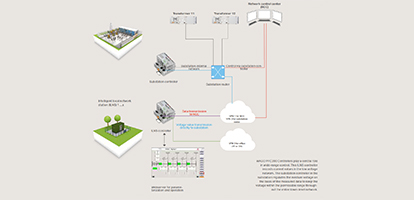

No network monitoring without transparency, no planning without monitoring, no network optimization without planning – to automatically compensate for bottlenecks in the low voltage network, distribution network operators need to keep an eye on the networks. The WAGO solution makes network visualization and control on the basis of online measurements easier.
Developing technologies and processes to reduce the strain on networks is a key goal of the energy industry. The latest developments include generation and load management via so-called wide-range control through the medium and low voltage network distribution networks. In the process, the medium voltages in the substations are regulated to keep the voltage within the allowed rage throughout the entire lower-level grid. This allows the maximum amount of renewable energy to be fed in and the voltage range to be maintained simultaneously at all points.
WAGO is among the forces driving this innovative type of network optimization. Substations with WAGO control and measurement technology are an essential component of wide-range control. In this approach, WAGO PFC200 Controllers function as a central data node in the stations: They collect the current values recorded by three-phase power measurement modules in the low voltage network and transfer them to the office network via a secure VPN connection, and if necessary, e.g. if a limit is exceeded, to the network control center via a second VPN connection. This allows the network planning employees to do a better and better job keeping an eye on the network with progress in telecontrol monitoring, to plan proactively and to react quickly in the event of faults.
The Network Becomes Transparent
The network station controller transfers voltage values to an additional WAGO controller in the 110 V substation in parallel. Special easy-to-operate software calculates the current state of the low voltage network on the basis of the measured values from the distant endpoints. The level control in the substations is optimized automatically on the basis of these calculations, reducing the burden on the network management in critical situations. Initial experience shows that the wide-range control can reduce the fluctuations in the network by almost 30 percent.
“Intelligent local network stations allow measurement, control, regulation and remote control and function partially automatically. The next step is now real network control in the low and medium voltage range. Online measurement is not new, but we now use it in a timely fashion to obtain knowledge that has many benefits for network operators,” says WAGO network expert Daniel Wiese. The most important benefit is that wide-range control can help companies reduce high network expansion costs, since, on the one hand, it allows the capacity of existing lines to be fully utilized, and on the other, the network information allows investments to be planned in a more targeted fashion. “Online measurement in the low and medium voltage ranges makes the network transparent.
This allows the network operators to easily identify where more or less primary technology is necessary,” says Wiese.
Modernization Instead of New Construction
The effects can already be felt clearly in the low voltage network in particular. The share of photovoltaic generation, as well as heat pumps other electric consumers, is constantly increasing; furthermore, strong growth in electromobility is anticipated in the coming years. “Integrating the charging station infrastructure this will require into the low voltage network will be a huge challenge,” says Wiese.
Subsections of the network are already approaching their capacity limits, which shows up in the low voltage range as frequency fluctuations and voltage variations occurring more and more often. The problem: The existing primary technology and the power lines are not prepared for the spread of renewable energies and electric vehicles in many places. They must be adjusted in such a way that grid stability is still guaranteed even with a consistent implementation of the energy transition. The current German government, a coalition of the two parties CDU/CSU and SPD, has clear ideas about how to ensure this in the future: The coalition agreement stipulates that the existing power grids should operate at higher capacity with new technologies and greater digitization, but also with better cooperation between the network operators.
New network codes, which are reflected in the new Technical Connection Rules (TCRs), also require transparency in the grid, so, for example, upstream and downstream network operators can communicate in critical emergency situations in the event of a fault. With network control, network operators would be right on course. “They can create real added value through perspicuous investment in hardware and, in future, through straightforward upgrades of the easy-to-use software,” says Wiese.
Text: Daniel Wiese, WAGO
Photo: WAGO